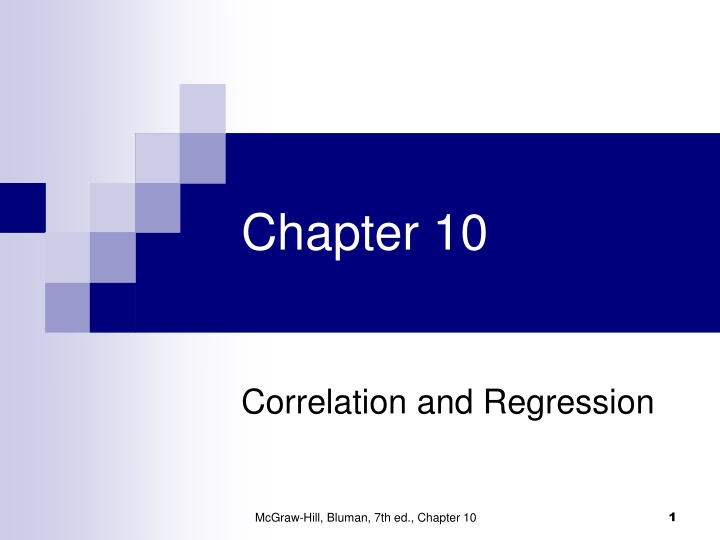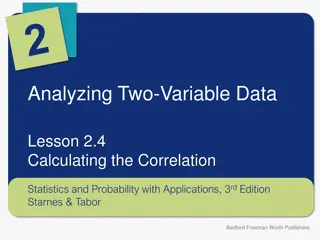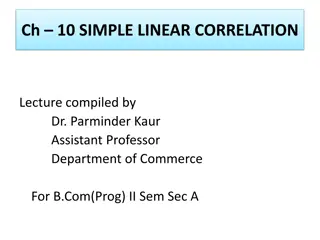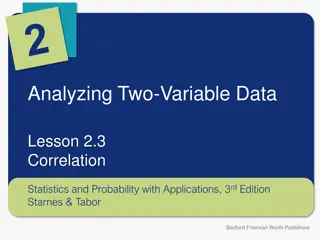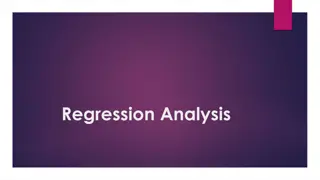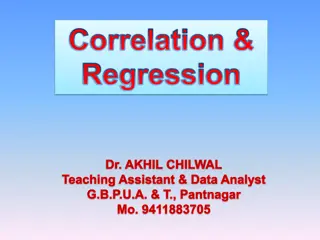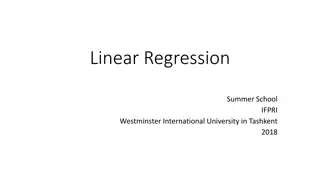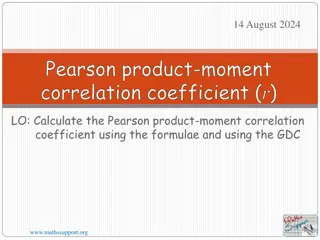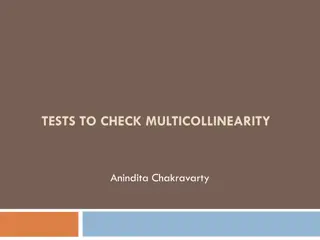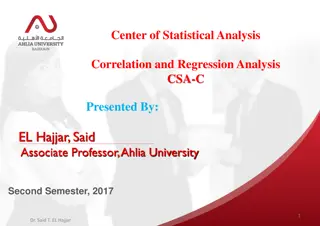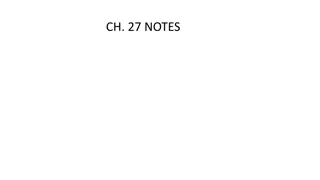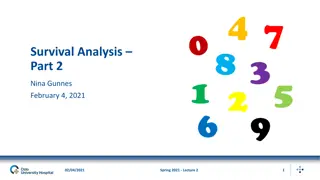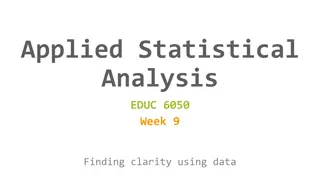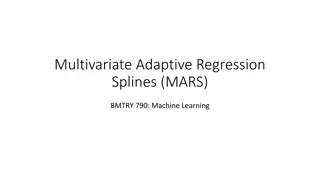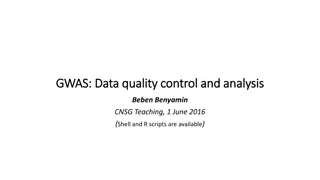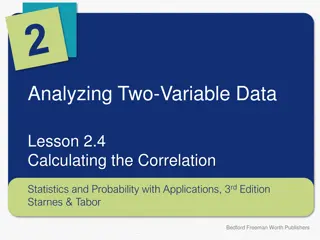Correlation and Regression Analysis Overview
This content covers the fundamentals of correlation and regression analysis in statistics. Learn how to draw scatter plots, compute correlation coefficients, test hypotheses, calculate regression lines, and more. Explore the relationship between variables, determine the strength of relationships, and make predictions based on statistical analysis.
Download Presentation

Please find below an Image/Link to download the presentation.
The content on the website is provided AS IS for your information and personal use only. It may not be sold, licensed, or shared on other websites without obtaining consent from the author.If you encounter any issues during the download, it is possible that the publisher has removed the file from their server.
You are allowed to download the files provided on this website for personal or commercial use, subject to the condition that they are used lawfully. All files are the property of their respective owners.
The content on the website is provided AS IS for your information and personal use only. It may not be sold, licensed, or shared on other websites without obtaining consent from the author.
E N D
Presentation Transcript
Chapter 10 Correlation and Regression 1 McGraw-Hill, Bluman, 7th ed., Chapter 10
Example 10-2: Absences/Final Grades Please enter the data below in L1 and L2. The data appears on page 537 of your textbook. Also make sure to have the graphs A, B, and C ready with their corresponding data. 2 Bluman, Chapter 10
Graph and Window: The next slides will outline how to calculate the regression model that may fit the data. The first time you ever run the regression you may have turn on the diagnostics. Once the diagnostic is turned on once, you may not have to do it again. 3 Bluman, Chapter 10
Chapter 10 Overview Introduction 10-1 Scatter Plots and Correlation 10-2 Regression 10-3 Coefficient of Determination and Standard Error of the Estimate 10-4 Multiple Regression (Optional) 4 Bluman, Chapter 10
Chapter 10 Objectives 1. Draw a scatter plot for a set of ordered pairs. 2. Compute the correlation coefficient. 3. Test the hypothesis H0: = 0. 4. Compute the equation of the regression line. 5. Compute the coefficient of determination. 6. Compute the standard error of the estimate. 7. Find a prediction interval. 8. Be familiar with the concept of multiple regression. 5 Bluman, Chapter 10
Introduction In addition to hypothesis testing and confidence intervals, inferential statistics involves determining whether a relationship between two or more numerical or quantitative variables exists. 6 Bluman, Chapter 10
Introduction Correlation is a statistical method used to determine whether a linear relationship between variables exists. Regressionis a statistical method used to describe the nature of the relationship between variables that is, positive or negative, linear or nonlinear. 7 Bluman, Chapter 10
Introduction The purpose of this chapter is to answer these questions statistically: 1. Are two or more variables related? 2. If so, what is the strength of the relationship? 3. What type of relationship exists? 4. What kind of predictions can be made from the relationship? 8 Bluman, Chapter 10
Introduction 1. Are two or more variables related? 2. If so, what is the strength of the relationship? To answer these two questions, statisticians use the correlation coefficient, a numerical measure to determine whether two or more variables are related and to determine the strength of the relationship between or among the variables. 9 Bluman, Chapter 10
Introduction 3. What type of relationship exists? There are two types of relationships: simple and multiple. In a simple relationship, there are two variables: an independent variable (predictor variable) and a dependent variable (response variable). In a multiple relationship, there are two or more independent variables that are used to predict one dependent variable. 10 Bluman, Chapter 10
Introduction 4. What kind of predictions can be made from the relationship? Predictions are made in all areas and daily. Examples include weather forecasting, stock market analyses, sales predictions, crop predictions, gasoline price predictions, and sports predictions. Some predictions are more accurate than others, due to the strength of the relationship. That is, the stronger the relationship is between variables, the more accurate the prediction is. 11 Bluman, Chapter 10
10.1 Scatter Plots and Correlation A scatter plot is a graph of the ordered pairs (x, y) of numbers consisting of the independent variable x and the dependent variable y. 12 Bluman, Chapter 10
Chapter 10 Correlation and Regression Section 10-1 Example 10-1 Page #536 13 Bluman, Chapter 10
Example 10-1: Car Rental Companies Construct a scatter plot for the data shown for car rental companies in the United States for a recent year. Step 1: Draw and label the x and y axes. Step 2: Plot each point on the graph. 14 Bluman, Chapter 10
Example 10-1: Car Rental Companies Positive Relationship 15 Bluman, Chapter 10
Chapter 10 Correlation and Regression Section 10-1 Example 10-2 Page #537 16 Bluman, Chapter 10
Example 10-2: Absences/Final Grades Construct a scatter plot for the data obtained in a study on the number of absences and the final grades of seven randomly selected students from a statistics class. Step 1: Draw and label the x and y axes. Step 2: Plot each point on the graph. 17 Bluman, Chapter 10
Example 10-2: Absences/Final Grades Negative Relationship 18 Bluman, Chapter 10
Chapter 10 Correlation and Regression Section 10-1 Example 10-3 Page #538 19 Bluman, Chapter 10
Example 10-3: Exercise/Milk Intake Construct a scatter plot for the data obtained in a study on the number of hours that nine people exercise each week and the amount of milk (in ounces) each person consumes per week. Step 1: Draw and label the x and y axes. Step 2: Plot each point on the graph. 20 Bluman, Chapter 10
Example 10-3: Exercise/Milk Intake Very Weak Relationship 21 Bluman, Chapter 10
Correlation The correlation coefficient computed from the sample data measures the strength and direction of a linear relationship between two variables. There are several types of correlation coefficients. The one explained in this section is called the Pearson product moment correlation coefficient (PPMC). The symbol for the sample correlation coefficient is r. The symbol for the population correlation coefficient is . 22 Bluman, Chapter 10
Correlation The range of the correlation coefficient is from 1 to +1. If there is a strong positive linear relationship between the variables, the value of r will be close to +1. If there is a strong negative linear relationship between the variables, the value of r will be close to 1. 23 Bluman, Chapter 10
Correlation 24 Bluman, Chapter 10
Correlation Coefficient The formula for the correlation coefficient is ( ( ) ( ) ( ) x )( ) n xy x y = r ( ) ( ) 2 2 2 2 n x n y y where n is the number of data pairs. Rounding Rule: Round to three decimal places. 25 Bluman, Chapter 10
Chapter 10 Correlation and Regression Section 10-1 Example 10-4 Page #540 26 Bluman, Chapter 10
Example 10-4: Car Rental Companies Compute the correlation coefficient for the data in Example 10 1. Cars x (in 10,000s) 63.0 29.0 20.8 19.1 13.4 8.5 x = 153.8 Income y (in billions) 7.0 3.9 2.1 2.8 1.4 1.5 y = 18.7 xy x2 y2 Company A B C D E F 441.00 113.10 43.68 53.48 18.76 2.75 xy= 682.77 3969.00 841.00 432.64 364.81 179.56 72.25 x2= 5859.26 49.00 15.21 4.41 7.84 1.96 2.25 y2= 80.67 27 Bluman, Chapter 10
Example 10-4: Car Rental Companies Compute the correlation coefficient for the data in Example 10 1. x = 153.8, y = 18.7, xy = 682.77, x2 = 5859.26, y2 = 80.67, n = 6 ( ) ( ( ) ( ) ( )( ( )( ) ( 6 5859.26 153.8 0.982 (strong positive relationship) = r )( ) n xy x y = r ( ) ( ) 2 2 2 2 n x x n y y ) ( )( ) 6 682.77 153.8 18.7 = r ) ( )( 6 80.67 ) ( ) 2 2 18.7 28 Bluman, Chapter 10
Chapter 10 Correlation and Regression Section 10-1 Example 10-5 Page #541 29 Bluman, Chapter 10
Example 10-5: Absences/Final Grades Compute the correlation coefficient for the data in Example 10 2. Number of absences, x 6 2 15 9 12 5 8 Final Grade y (pct.) 82 86 43 74 58 90 78 xy 492 172 645 666 696 450 624 x2 36 4 y2 Student A B C D E F G 6,724 7,396 1,849 5,476 3,364 8,100 6,084 225 81 144 25 64 x2= 579 y2= 38,993 x = 57 y = 511 xy= 3745 30 Bluman, Chapter 10
Example 10-5: Absences/Final Grades Compute the correlation coefficient for the data in Example 10 2. x = 57, y = 511, xy = 3745, x2 = 579, y2 = 38,993, n = 7 ( ) ( ( ) ( ) ( )( ) ( ( )( ) ( ) ( )( 7 579 57 0.944 (strong negative relationship) = r )( ) n xy x y = r ( ) ( ) 2 2 2 2 n x x n y y )( ) 7 3745 57 511 = r ) ( ) 2 2 7 38,993 511 31 Bluman, Chapter 10
Turning the diagnostic On: Press 2nd 0 to access CATALOG Press the down arrow key to access DiagnosticOn Press ENTER twice. 32
Calculating Linear regression: ? = 3.622? + 102.492 What is the independent variable? What is the dependent variable? What is the value of slope and what does it mean? What is the value of the y-intercept and what does it mean? 33 Bluman, Chapter 10
Chapter 10 Correlation and Regression Section 10-1 Example 10-6 Page #542 34 Bluman, Chapter 10
Example 10-6: Exercise/Milk Intake Compute the correlation coefficient for the data in Example 10 3. xy 144 x2 9 0 4 25 64 25 y2 Subject Hours, x 3 0 2 5 8 5 10 2 1 Amount y 48 A B C D E F G H I 2,304 8 0 64 32 64 10 32 56 72 48 64 1,024 4,096 100 1,024 3,136 5,184 2,304 320 80 160 560 144 48 100 4 1 x2= 232 y2= 19,236 x = 36 y = 370 xy= 1,520 35 Bluman, Chapter 10
Example 10-6: Exercise/Milk Intake Compute the correlation coefficient for the data in Example 10 3. x = 36, y = 370, xy = 1520, x2 = 232, y2 = 19,236, n = 9 ( ) ( ( ) ( ) ( )( ) ( ( )( ) ( ) 7 232 36 0.067 (very weak relationship) = r )( ) n xy x y = r ( ) ( ) 2 2 2 2 n x x n y y )( ) 7 1520 36 370 = r ( )( 7 19,236 ) ( ) 2 2 370 36 Bluman, Chapter 10
Hypothesis Testing In hypothesis testing, one of the following is true: H0: = 0 This null hypothesis means that there is no correlation between the x and y variables in the population. H1: 0 This alternative hypothesis means that there is a significant correlation between the variables in the population. 37 Bluman, Chapter 10
t Test for the Correlation Coefficient 2 n = t r 2 1 r with degrees of freedom equal to 2. n 38 Bluman, Chapter 10
Chapter 10 Correlation and Regression Section 10-1 Example 10-7 Page #544 39 Bluman, Chapter 10
Example 10-7: Car Rental Companies Test the significance of the correlation coefficient found in Example 10 4. Use = 0.05 and r = 0.982. Step 1: State the hypotheses. H0: = 0 and H1: 0 Step 2: Find the critical value. Since = 0.05 and there are 6 2 = 4 degrees of freedom, the critical values obtained from Table F are 2.776. 40 Bluman, Chapter 10
Example 10-7: Car Rental Companies Step 3: Compute the test value. = 6 0.982 2 2 n = = 0.982 10.4 t r ( ) 2 2 1 r 1 Step 4: Make the decision. Reject the null hypothesis. Step 5: Summarize the results. There is a significant relationship between the number of cars a rental agency owns and its annual income. 41 Bluman, Chapter 10
Chapter 10 Correlation and Regression Section 10-1 Example 10-8 Page #545 42 Bluman, Chapter 10
Example 10-8: Car Rental Companies Using Table I, test the significance of the correlation coefficient r = 0.067, from Example 10 6, at = 0.01. Step 1: State the hypotheses. H0: = 0 and H1: 0 There are 9 2 = 7 degrees of freedom. The value in Table I when = 0.01 is 0.798. For a significant relationship, r must be greater than 0.798 or less than -0.798. Since r = 0.067, do not reject the null. Hence, there is not enough evidence to say that there is a significant linear relationship between the variables. 43 Bluman, Chapter 10
Possible Relationships Between Variables When the null hypothesis has been rejected for a specific a value, any of the following five possibilities can exist. 1. There is a direct cause-and-effect relationship between the variables. That is, x causes y. 2. There is a reverse cause-and-effect relationship between the variables. That is, y causes x. 3. The relationship between the variables may be caused by a third variable. 4. There may be a complexity of interrelationships among many variables. 5. The relationship may be coincidental. 44 Bluman, Chapter 10
Possible Relationships Between Variables 1. There is a reverse cause-and-effect relationship between the variables. That is, y causes x. For example, water causes plants to grow poison causes death heat causes ice to melt 45 Bluman, Chapter 10
Possible Relationships Between Variables 2. There is a reverse cause-and-effect relationship between the variables. That is, y causes x. For example, Suppose a researcher believes excessive coffee consumption causes nervousness, but the researcher fails to consider that the reverse situation may occur. That is, it may be that an extremely nervous person craves coffee to calm his or her nerves. 46 Bluman, Chapter 10
Possible Relationships Between Variables 3. The relationship between the variables may be caused by a third variable. For example, Ifa statistician correlated the number of deaths due to drowning and the number of cans of soft drink consumed daily during the summer, he or she would probably find a significant relationship. However, the soft drink is not necessarily responsible for the deaths, since both variables may be related to heat and humidity. 47 Bluman, Chapter 10
Possible Relationships Between Variables 4. There may be a complexity of interrelationships among many variables. For example, A researcher may find a significant relationship between students high school grades and college grades. But there probably are many other variables involved, such as IQ, hours of study, influence of parents, motivation, age, and instructors. 48 Bluman, Chapter 10
Possible Relationships Between Variables 5. The relationship may be coincidental. For example, A researcher may be able to find a significant relationship between the increase in the number of people who are exercising and the increase in the number of people who are committing crimes. But common sense dictates that any relationship between these two values must be due to coincidence. 49 Bluman, Chapter 10
On Your own: Read section 10.1 Study the vocabulary words discussed in class the bold words in your reading. Assignment: Page 548 Sec 10.1 1-11 all, 13, 17, 19 50
